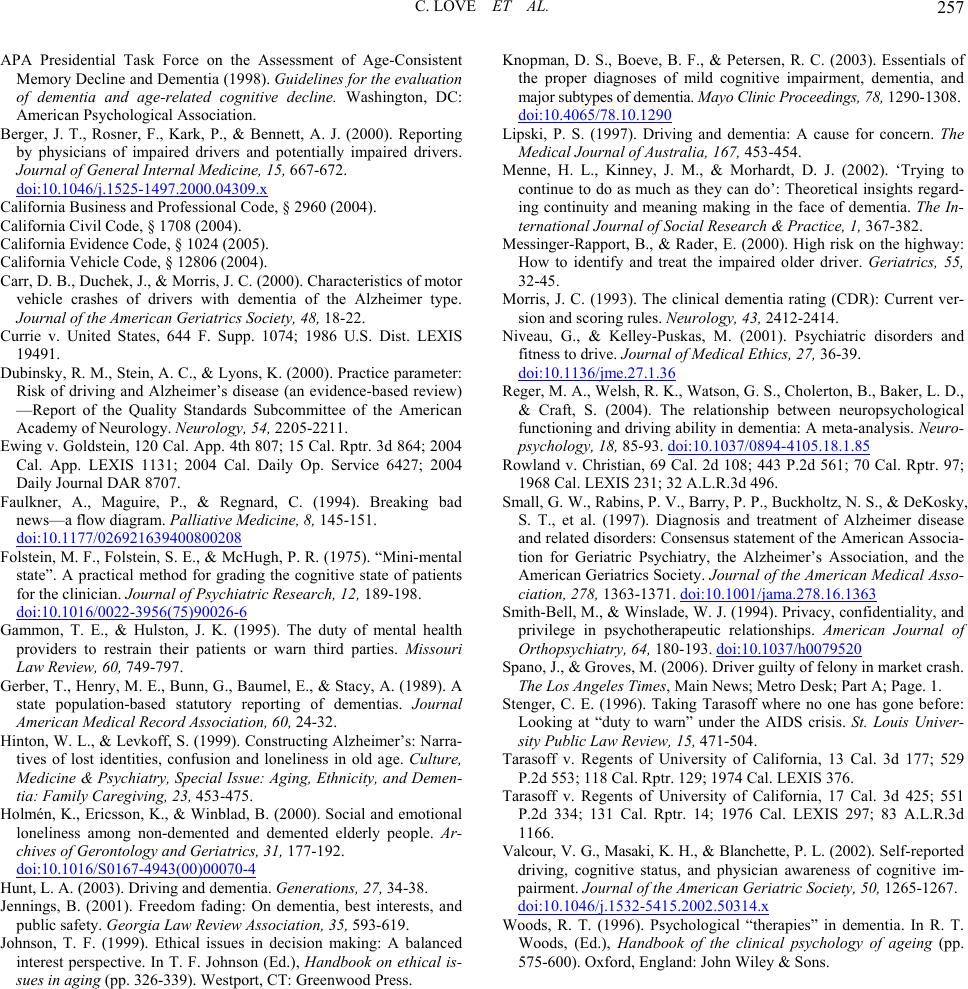
C. LOVE ET AL. 257
APA Presidential Task Force on the Assessment of Age-Consistent
Memory Decline and Dementia (1998). Guidelines for the evaluation
of dementia and age-related cognitive decline. Washington, DC:
American Psychological Association.
Berger, J. T., Rosner, F., Kark, P., & Bennett, A. J. (2000). Reporting
by physicians of impaired drivers and potentially impaired drivers.
Journal of General Interna l M e d i c i n e , 15, 667-672.
doi:10.1046/j.1525-1497.2000.04309.x
California Business and Profess ion al Cod e, § 2960 (2004).
California Civil Code, § 1708 (2004) .
California Evidence Code, § 1024 (2005).
California Vehicle Code, § 12806 (2004).
Carr, D. B., Duchek, J., & Morris, J. C. (2000). Characteristics of motor
vehicle crashes of drivers with dementia of the Alzheimer type.
Journal of the American Ge r i atrics Society, 48, 18-22.
Currie v. United States, 644 F. Supp. 1074; 1986 U.S. Dist. LEXIS
19491.
Dubinsky, R. M., Stein, A. C., & Lyons, K. (2000). Practice parameter:
Risk of driving and Alzheimer’s disease (an evidence-based review)
—Report of the Quality Standards Subcommittee of the American
Academy of Neurology. Neurology, 54, 2205-2211.
Ewing v. Goldstein, 120 Cal. App. 4th 807; 15 Cal. Rptr. 3d 864; 2004
Cal. App. LEXIS 1131; 2004 Cal. Daily Op. Service 6427; 2004
Daily Journal DAR 8707.
Faulkner, A., Maguire, P., & Regnard, C. (1994). Breaking bad
news—a flow diagram . Palliative Medicine, 8, 145-151.
doi:10.1177/026921639400800208
Folstein, M. F., Folstein, S. E., & McHugh, P. R. (1975). “Mini-mental
state”. A practical method for grading the cognitive state of patients
for the clinician. Journal of Psychiatric Resea rch, 12, 189-198.
doi:10.1016/0022-3956(75)90026-6
Gammon, T. E., & Hulston, J. K. (1995). The duty of mental health
providers to restrain their patients or warn third parties. Missouri
Law Review, 60, 749-797.
Gerber, T., Henry, M. E., Bunn, G., Baumel, E., & Stacy, A. (1989). A
state population-based statutory reporting of dementias. Journal
American Medical Record Association , 60, 24-32.
Hinton, W. L., & Levkoff, S. (1999). Constructing Alzheimer’s: Narra-
tives of lost identities, confusion and loneliness in old age. Culture,
Medicine & Psychiatry, Special Issue: Aging, Ethnicity, and Demen-
tia: Family Caregiving, 23, 453-475.
Holmén, K., Ericsson, K., & Winblad, B. (2000). Social and emotional
loneliness among non-demented and demented elderly people. Ar-
chives of Gerontology and Geriatric s, 31, 177-192.
doi:10.1016/S0167-4943(00)00070-4
Hunt, L. A. (2003). Driving and dementia. Generations, 27, 34-38.
Jennings, B. (2001). Freedom fading: On dementia, best interests, and
public safety. Georgia Law Revie w As so cia ti on , 35, 593-619.
Johnson, T. F. (1999). Ethical issues in decision making: A balanced
interest perspective. In T. F. Johnson (Ed.), Handbook on ethical is-
sues in aging (pp. 326-339). Westport, CT: Greenwood Press.
Knopman, D. S., Boeve, B. F., & Petersen, R. C. (2003). Essentials of
the proper diagnoses of mild cognitive impairment, dementia, and
major subtypes of dementia. Mayo Clinic Proceedings, 78, 1290- 1 3 08 .
doi:10.4065/78.10.1290
Lipski, P. S. (1997). Driving and dementia: A cause for concern. The
Medical Journal of Australia, 167 , 453-454.
Menne, H. L., Kinney, J. M., & Morhardt, D. J. (2002). ‘Trying to
continue to do as much as they can do’: Theoretical insights regard-
ing continuity and meaning making in the face of dementia. The In-
ternational Journal of So c i al Research & Practice, 1, 367-382.
Messinger-Rapport, B., & Rader, E. (2000). High risk on the highway:
How to identify and treat the impaired older driver. Geriatrics, 55,
32-45.
Morris, J. C. (1993). The clinical dementia rating (CDR): Current ver-
sion and scoring rules. Neurology, 43, 2412-2414.
Niveau, G., & Kelley-Puskas, M. (2001). Psychiatric disorders and
fitness to drive. Journal of M ed ic a l Ethics, 27, 36-39.
doi:10.1136/jme.27.1.36
Reger, M. A., Welsh, R. K., Watson, G. S., Cholerton, B., Baker, L. D.,
& Craft, S. (2004). The relationship between neuropsychological
functioning and driving ability in dementia: A meta-analysis. Neuro-
psychology, 18, 85-93. doi:10.1037/0894-4105.18.1.85
Rowland v. Christian, 69 Cal. 2d 108; 443 P.2d 561; 70 Cal. Rptr. 97;
1968 Cal. LEXIS 231; 32 A.L.R.3d 496.
Small, G. W., Rabins, P. V., Barry, P. P., Buckholtz, N. S., & DeKosky,
S. T., et al. (1997). Diagnosis and treatment of Alzheimer disease
and related disorders: Consensus statement of the American Associa-
tion for Geriatric Psychiatry, the Alzheimer’s Association, and the
American Geriatrics Society. Journal of the American Medical Asso-
ciation, 278, 1363-1371. doi:10.1001/jama.278.16.1363
Smith-Bell, M., & Winslade, W. J. (1994). Privacy, confidentiality, and
privilege in psychotherapeutic relationships. American Journal of
Orthopsychiatry, 64, 180-193. doi:10.1037/h0079520
Spano, J., & Groves, M. (2006). Driver guilty of felony in market crash.
The Los Angeles Times, Main News; Metro Desk; Part A; Page. 1.
Stenger, C. E. (1996). Taking Tarasoff where no one has gone before:
Looking at “duty to warn” under the AIDS crisis. St. Louis Univer-
sity Public Law Review, 15, 471-504.
Tarasoff v. Regents of University of California, 13 Cal. 3d 177; 529
P.2d 553; 118 Cal. Rptr. 129; 1974 Cal. LEXIS 376.
Tarasoff v. Regents of University of California, 17 Cal. 3d 425; 551
P.2d 334; 131 Cal. Rptr. 14; 1976 Cal. LEXIS 297; 83 A.L.R.3d
1166.
Valcour, V. G., Masaki, K. H., & Blanchette, P. L. (2002). Self-r epor ted
driving, cognitive status, and physician awareness of cognitive im-
pairment. Journal of the American Geria t r i c S o c i e t y , 50, 1265-1267.
doi:10.1046/j.1532-5415.2002.50314.x
Woods, R. T. (1996). Psychological “therapies” in dementia. In R. T.
Woods, (Ed.), Handbook of the clinical psychology of ageing (pp.
575-600). Oxford, England: John Wiley & Sons.